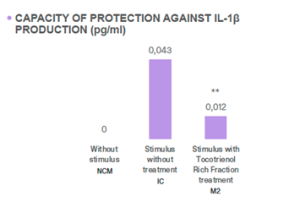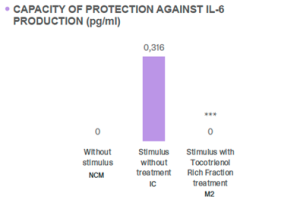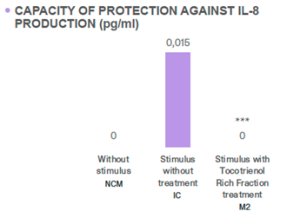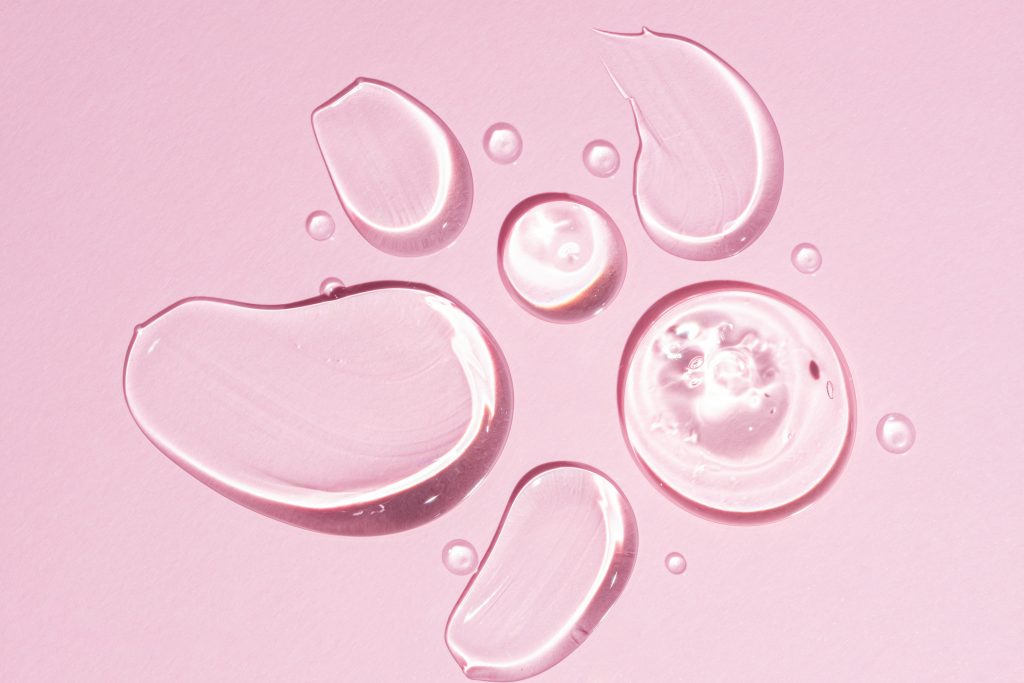Vitamin E is not a singular compound but a family of eight fat-soluble molecules divided into two main categories: tocopherols and tocotrienols. Each possesses distinct structural, chemical, and biological properties, significantly influencing vitamin E antioxidant behavior in cosmetic formulations.
Structural differences between tocotrienols and tocopherols
The vitamin E family is composed of eight naturally occurring analogs, split into two subgroups: four tocopherols (α-, β-, γ-, and δ-) and four tocotrienols (α-, β-, γ-, and δ-).
Tocotrienols and tocopherols and share a chromanol ring, the functional group responsible for vitamin E antioxidant activity. Their main difference is the side chain attached to it. Tocopherols possess a saturated phytyl tail, while tocotrienols feature an unsaturated isoprenoid tail with three double bonds. This structural distinction significantly impacts their mobility within lipid membranes and their biological behavior in the skin.
The variations among the α-, β-, γ-, and δ- analogs are defined by the number and position of methyl groups on the chromanol ring. For instance, α-analogs are tri-methylated, while δ-forms carry only one methyl group. These subtle differences influence not only the antioxidant capacity of each compound but also their interactions with biological membranes, receptors, and metabolic pathways.
Vitamin E tocopherols, especially D-α-tocopherol, also known as natural vitamin E, are more prevalent in the human body due to their higher affinity for tocopherol transfer proteins (TTP), which preferentially bind to α-tocopherol and facilitate its incorporation into tissues. In contrast, tocotrienols, although less common in systemic circulation, exhibit superior penetration into cell membranes and tissues rich in saturated fats due to 3 unsaturated bonds in the carbon side chain.
The structural variations also extend to stereochemistry. Natural tocopherols contain three chiral centers and are predominantly found as the D-α form (RRR-α-tocopherol), while tocotrienols have a single stereocenter and occur as trans-isomers when derived from natural sources. This also has implications for bioavailability and biological activity, especially in topical formulations.
Antioxidant potency and stability: which vitamin E form performs best in cosmetic applications?
Antioxidant performance is central to the role of vitamin E in skincare and other cosmetics, primarily through its ability to neutralize free radicals and reduce oxidative stress induced by environmental aggressors such as UV radiation and pollution.
If you are wondering: which is better, tocotrienol or tocopherol?
Regarding antioxidant activity, studies consistently show that vitamin E tocotrienols exhibit significantly stronger antioxidant activity than tocopherols. This is attributed to their better distribution in cell membranes, better absorption by the skin, and their ability to rotate freely within lipid layers, enabling more efficient scavenging of reactive oxygen species (ROS).
In in vitro models, tocotrienol-rich fractions (TRFs) effectively reduce oxidative damage, suppress inflammation, and preserve collagen integrity in dermal fibroblasts exposed to stressors such as hydrogen peroxide and UV irradiation. Specifically, γ-tocotrienol has been shown to upregulate collagen synthesis genes (COL1A1 and COL3A1), reduce the expression of matrix metalloproteinases (MMPs), and inhibit apoptotic signaling pathways [1].
Moreover, in an in vitro study carried out by Btsa, 1% Bioxan® Tocotrienols have demonstrated protective effects in human keratinocyte models, the main epidermal cells involved in the inflammatory response. They significantly reduce pro-inflammatory cytokines such as IL-1β, IL-6, and IL-8 following exposure to an inflammatory agent, as shown in Figures 1, 2, and 3.

Figure 1. Changes in IL-1β in human keratinocytes treated with 1% Bioxan® Tocotrienols. NMC: The inflammatory agent significantly increased expression relative to the baseline control (p < 0.001). M2 prevented the increase in interleukin levels statistically significantly (p < 0.01) by 0.31 pg/ml. Negative Control Medium; IC: Inflammation Control; M2: Bioxan Palm Tocotrienol 50 at 1% treatment.

Figure 2. Changes in IL-6 in human keratinocytes treated with 1% Bioxan® Tocotrienols. The inflammatory agent significantly increased expression relative to baseline control (p < 0.001). M2 prevented the increase in interleukin levels statistically significantly (p < 0.01) by 0.316 pg/ml. NMC: Negative Control Medium; IC: Inflammation Control; M2: Bioxan® Palm Tocotrienol 50 at 1% treatment.

Figure 3. Changes in IL-8 in human keratinocytes treated with 1% Bioxan® Tocotrienols. NMC: The inflammatory agent significantly increased expression relative to baseline control (p < 0.001). M2 prevented the increase in interleukin 8 synthesis in a statistically significantly (p < 0.001) by 0.015 pg/ml. Negative Control Medium; IC: Inflammation Control; M2: Bioxan® Palm Tocotrienol 50 at 1% treatment.
Prolonged exposure to external factors such as UV radiation and pollution induces oxidative stress, which can disrupt cellular homeostasis and lead to DNA damage, lipid peroxidation, and mitochondrial dysfunction. This may trigger an inflammatory response in the skin through the activation of keratinocytes and the release of pro-inflammatory cytokines. These results make tocotrienols particularly well-suited for combating “inflamm’aging”, the chronic low-grade inflammation associated with skin aging.
Formulation strategies: maximizing bioavailability and efficacy of vitamin E in cosmetic products
To ensure optimal skin absorption and ingredient protection:
- Tocotrienols could be incorporated into stable delivery systems such as emulsions, nanoencapsulation, or lipid-based carriers.
- The choice of excipients, pH, and packaging can further influence the integrity and efficacy of tocotrienol-containing formulations.
- The selection of natural antioxidant sources supports the growing demand for clean-label and sustainably sourced ingredients in the cosmetic industry.
At Btsa, we specialize in the integration of tocotrienols in innovative cosmetic formulations. Bioxan® Tocotrienols are powerful natural antioxidants for skin care. They deliver antioxidant and unique anti-inflammatory benefits by neutralizing ROS and inhibiting pro-inflammatory cytokines. This helps protect structural proteins like collagen and preserves skin integrity, visibly delaying signs of ageing. They are available from palm oil or rice bran oil.
Tocotrienols are essential for cosmetic developers seeking to deliver high-efficacy skincare solutions that respond to both physiological skin needs and consumer expectations for science-backed, natural ingredients.
References
[1] Makpol S, Abidin AZ, Sairin K, Mazlan M, Top GM, Ngah WZ. gamma-Tocotrienol prevents oxidative stress-induced telomere shortening in human fibroblasts derived from different aged individuals. Oxid Med Cell Longev. 2010 Jan-Feb;3(1):35-43. doi: 10.4161/oxim.3.1.9940.

